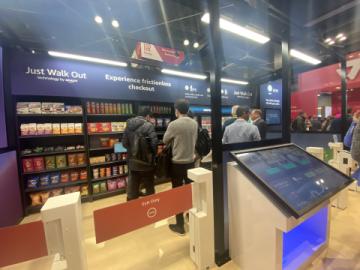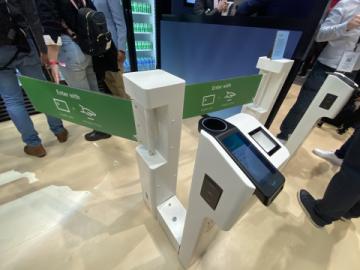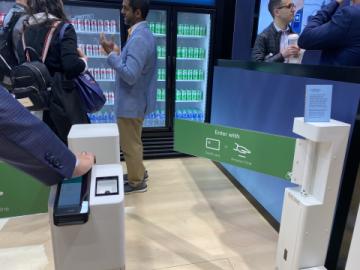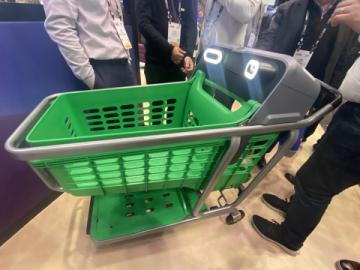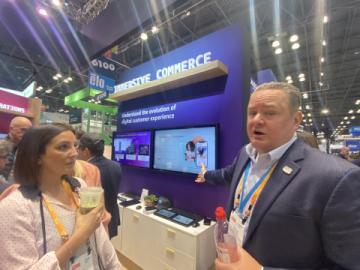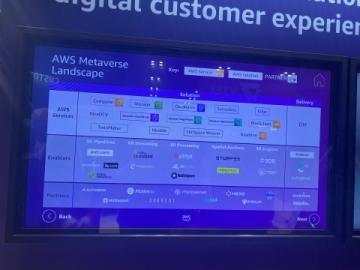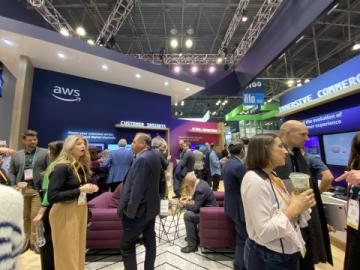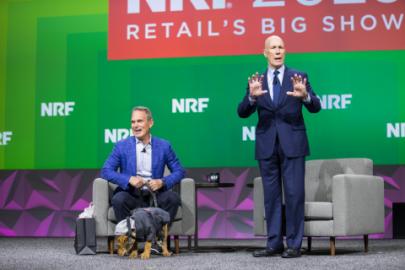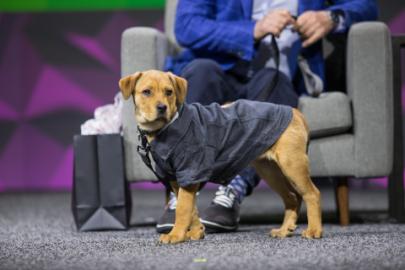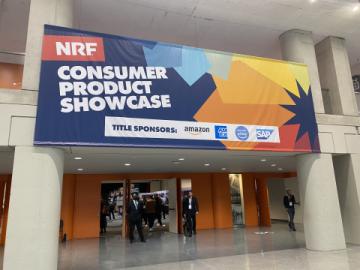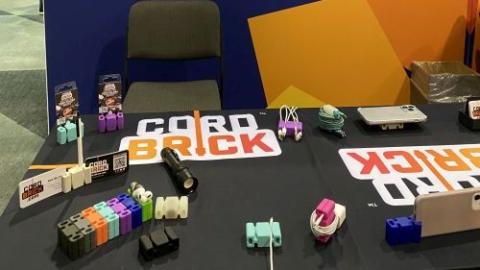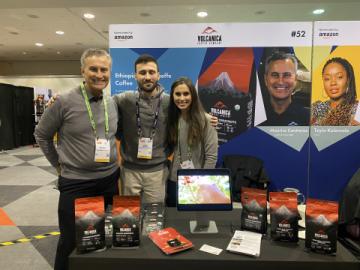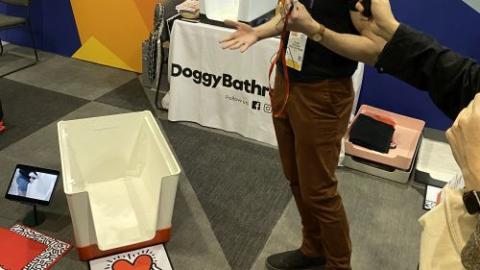Best of NRF 2023: Top 10 Takeaways
NRF 2023 was one of the busiest in recent memory. While it was physically impossible to see everything, RIS News has you covered, with our comprehensive, curated take on the most vital retail news, trends, and sessions from Retail’s Biggest Show.
Below you’ll find the top takeaways from The Big Show 2023, presented in 10-not-to-be-missed highlights from keynote presentations, to session coverage and eye-catching booths, to the consumer product showcase, and NRF tech and research announcements.
What word encompasses this year’s massive turnout of retail executives, thought leaders, and technology providers — and what they have in store for the remainder of the year? Here’s what attendees had to say:
1. Keynotes Set the Stage for Action-Packed NRF 2023
Sunday, January 15
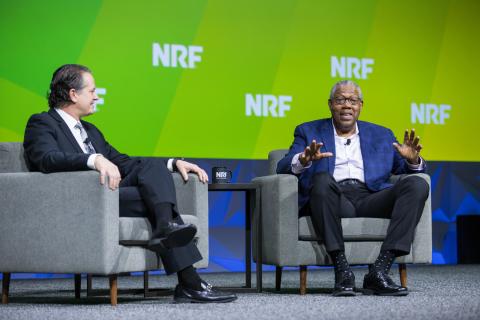
Excited attendees packed out the keynote session hall to hear Walmart U.S. president and CEO John Furner in conversation with Harvard Business School’s Dr. James Cash during The Huddle With John Furner. In a live video recording format of Furner’s popular podcast, The Huddle, the two industry leaders took stock of the current state of retail, highlighting opportunities and acknowledging the challenges on the horizon.
“Loyalty in retail is the absence of something better,” Furner shared, leaving attendees with plenty to consider about what it means to be better — or even the best — in the retail industry today.
Dr. Cash also shared perspectives and anecdotes from his decades-long career, but when asked to describe our new normal, he was of the opinion that not much had really changed.
“The new normal is the old normal because in retail, the communities of people we serve have a clear calculus,” Cash explained. “The technology causes you to do things a little differently, but the calculus is the same. This is a treadmill and our performance on the treadmill will continue to be evaluated on that same criteria.”
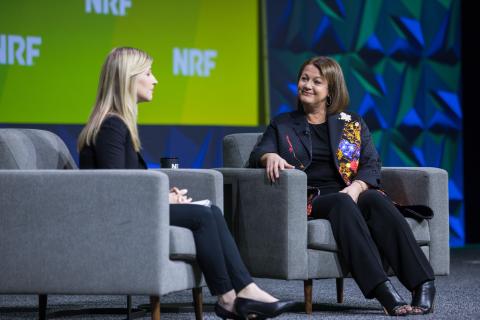
Next up, Saks OFF 5TH president and CEO, Paige Thomas sat down with CNBC’s Melissa Repko to give her take on how to stay the course in the face of uncertainty and challenging macroeconomic factors during Off-Price Luxury Writes Path to Success in Uncertain Times.
“It’s been a wild ride these past few years and we’ve been devoting a lot of energy to monitoring our customers,” Thomas shared. “At Saks OFF 5TH, our value proposition is our winning agenda. As we saw in the holiday season, and as we’ve seen on an ongoing basis, it really is about great brands at incredible prices.”
In closing, Thomas shared two key elements that drive Saks’ winning agenda: customer engagement and customer experience. “The answer always lies with the customer. One part of it is engagement — customer acquisition. The other is the customer experience, the customer journey. Do everything you can to smooth the path.”
Rounding out the day one keynotes, Macy’s chairman and CEO Jeff Gennette shared his thoughts on the year ahead, touching on everything from tech investments, to cash flow, to the retailer’s ongoing investment in DE&I efforts.
“It’s a point to say, be cautious, but be ready to pounce when opportunities and signals present themselves,” Genette said.
Monday, January 16
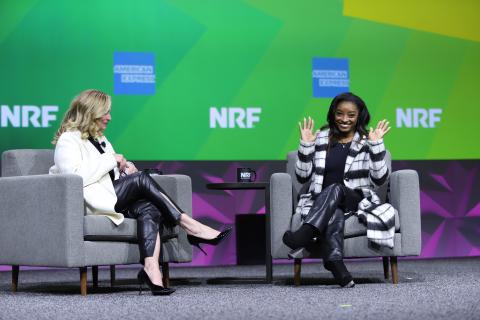
Monday morning kicked off in a spirited way with a captivating keynote session — Power. Perseverance. Passion — featuring Martine Reardon, chief marketing officer and EVP of content and membership at NRF, and guest speaker Simone Biles, decorated Olympic gymnast and now businesswoman.
The session drew parallels between the worlds of gymnastics and retail, finding that power, perseverance, and passion (and teamwork!) are all traits needed to succeed in leadership positions across both environments.
“Growing up in the gymnastics world taught me to never give up and always push forward,” said Biles. “If you make decisions, you might be the only one who believes in yourself, and you have to dig deep and remember what you stand for and what you want to accomplish.”
Even as a young child, Biles knew she was more persistent than the average kid. When she wanted to figure something out, she simply imitated those who were doing it the best — something she’s carried on throughout her career and now into her business venture with Athleta.
Biles has launched Athleta Girl X Simone Biles, a limited-edition collection of apparel designed for inclusivity, comfort, and self-confidence.
“I’ve looked at other athletes and how they’ve transitioned to business…gymnastics won't be my only legacy. I can carry it on to something else,” said Biles. “I can continue to make my dreams come true even when I've accomplished my wildest dreams already.”
The conversation of inclusivity and diversity carried into the next keynote — The Future of Retail Leadership — featuring a panel of Target executives: Brian Cornell, CEO; Kiera Fernandez, SVP and chief diversity and inclusion officer; Christina Hennington, EVP and chief growth officer; Alexis Sheppert, group vice president of stores for Virginia and North Carolina; and Cara Sylvester, EVP and chief guest experience officer.
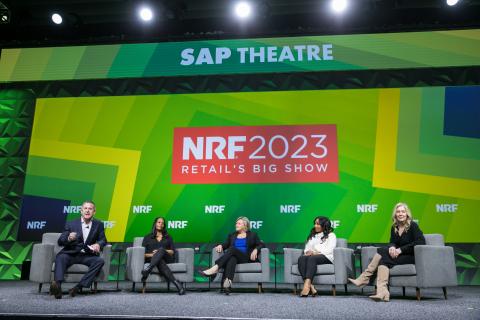
The conversation focused heavily on culture as the foundation that holds leadership accountable to actually delivering on inclusivity and diversity. Here’s what the panel had to say:
“The culture is the ‘who we are’ and ‘how we work,’ and the strategy is ‘what we do’ — those are natural compliments. We use the culture much more prescriptive as a guidepost for decisions we make in the business, both big and small.” — Hennington
“We design our store experience over building a deep connection with our guests. We are their happy place. These moments don’t just happen by chance. They happen because of our culture of care and core values of inclusivity. They run deep across 4,000 team members. When our guests feel seen, that brings more joy in their lives.” — Sylvester
“We spoke to local store leaders and had such an impactful conversation about how the target culture has impacted both their personal and business lives.” — Sheppert
“We asked them what are the sentiments when you think about working at Target, and they were a sense of family, connection, how we come together to accomplish different things. It captures the voice of the team.” — Hernandez
“You can't put culture aside even for a day or a moment,” said Cornell. “We know we have to embrace it each and every day. For every part of the organization, for our guests, and for our communities. It's not just something that just sits on the wall, but how we lead and how we run the business.”
2. Eye-Catching Booths
On the show floor there are always a few standout booths displaying dazzling tech to attendees. Amazon Web Services (AWS) was one example, packed with attendees checking out cutting-edge technology such as Just Walk Out by Amazon. The theme of the booth was unified commerce, and AWS had an array of physical and digital commerce innovations on display. Frictionless checkout was a big focus, including: Amazon One tech where shoppers pay with their palm; Just Walk Out, displaying how its store kits might work in a 400-3,000-square-foot space; and the Amazon Dash Cart, which allows shoppers to scan and item and drop it in the cart, exiting through dedicated lanes to be checked out instantly through their mobile app.
Immersive Retail was also featured, including how the company is achieving personalization through AR/VR, the metaverse, virtual try-on, live stream commerce, virtual stores, and more. Additionally, Amazon’s Buy with Prime direct-to-consumer offering for merchants’ own online stores was on display. The company just revealed the wide availability of its services and an upcoming integration with BigCommerce, the first e-commerce platform to integrate with Buy with Prime. Previously available to retailers by invitation only, Buy with Prime will be widely available to all U.S.-based merchants by January 31.
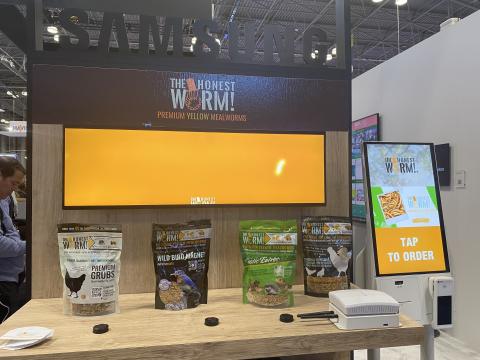
Samsung’s booth once again displayed its dazzling digital screen solutions, including the new Samsung Kiosk Windows 10 IoT Enterprise edition. Additionally, the booth showcased how Samsung delivers full retail sensory experiences. For example, Samsung brands, including Harman and MagicINFO, are using technology at the booth to trigger the senses of NRF attendees through sight, touch, sound, and even smell. A maple donut scent filled the air, where Samsung displayed its work with Duck Donuts, and The Honest Worm was on hand to demonstrate how retailers are embracing display solutions in stores with shelf displays and endless aisle — solutions which help smaller brands share their story.
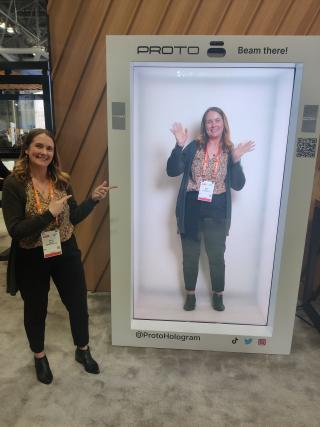
Over at the Verizon Business booth, there were three hands-on digital technologies to check out. Firstly, the Hologram Experience allowed visitors to project themselves, Jetsons-like, into an uncanny digital copy on the other side of the room. Verizon execs predict this technology could be used in video conferencing, as well as in stores for selling products. Attendees also helped themselves to goodies at Verizon’s 5G Edge Cashierless Checkout, and witnessed the future of returns at the 5G Edge Quality Assurance for Warehouse solution, which uses computer-vision and AI to streamline the post-purchase process.
3. Session Quick-Hitters: Technology and People
Building a Dynamic Frontline Workforce
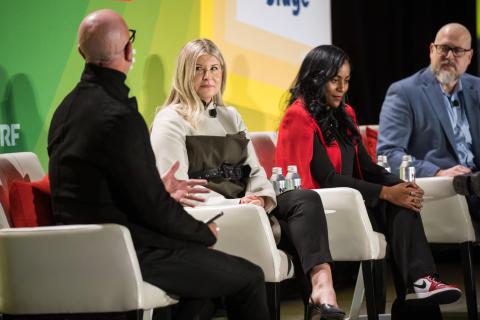
“Success is not a solo sport,” Marie Ford, VP of customer experience and front store innovation, CVS Health, said during “The Great Reshuffle: Building and Sustaining a Dynamic Frontline workforce.”
She was joined on stage by Jessica Cloutier, senior director of styling, Nordstrom; Reece Roberson, VP human resources business partner, stores, Lowe’s; and Ron Thurston, host of Retail in America, to discuss how retailers are reinventing how they motivate and empower staff. Ford gave the advice of two things she tells anyone: “Find purpose in the work that you do” and “make sure you have a sense of belonging.”
Roberson followed by noting the executive leadership team at Lowe’s is unapologetic about their support of the frontline. CEO Marvin Ellison, who received NRF’s The Visionary award this year, reminds the team often that there are only two jobs at Lowe’s: “You either serve customers or you serve those who serve customers.”
Roberson talked about how Lowe’s is working on “a little less conversation, a little more action,” including making investments from wage compensation for the frontline to adding leadership development programs and more. “We’re trying to have really good jobs that get people excited about being in retail.”
Cloutier explained that those who love to work in fashion “value flexibility, I think more so than ever before.” She also touched on how Nordstrom had to onboard its employees to help customers in front of them, as well as digitally, translating this great heritage of service that Nordstrom offers. Looking to the future, she said, “I’m mostly excited about how we can give great service now even when the customer isn’t right in front of us.”
Roberson said one of the things the company is excited about is building out its value proposition to continue to improve the lives of its associates, as well as leveraging technology such as artificial intelligence. Lowe’s rolled out Lucy, a virtual hiring assistant, taking a clunky hiring process that took almost seven days to screen a candidate from application down to a confirmed interview in 14 minutes.
Ford said what CVS is most excited about is “how we are reimagining career paths for our frontline colleagues,” creating both vertical and horizontal career paths. “In retail, you have people who just have a passion for caring and for people in general, and we can build those skills and offer them careers both horizontally and vertically.”
[Help RIS News honor retail’s technology leaders. We're currently accepting nominations for the 12th Annual CIO of the Year Award]
Defining and Leveraging Digital Twins
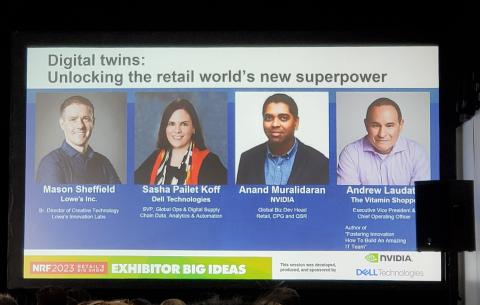
While digital twin technology has been implemented in the retail industry for years, many brands are just now beginning to understand the true potential, unlocking their transformative ability to leverage data in new ways. The topic was discussed at length during the “Digital Twins: Unlocking the Retail World’s New Superpower” session.
Panelist Mason Sheffield, senior director of creative technology Lowe’s Innovation Labs, defined digital twins as a digital representation of a physical place or system. “It’s also usually tied to live data sources,” he said. “This makes it a very powerful platform to do simulations and process optimization in ways not possible before.”
While the tech has many use cases, Lowe’s has been working with avatars to understand how consumers travel throughout the store (and at what time of day). What are their attachment products? What type of cart are they building? How might this change how product locations might shift?
Another benefit is being able to see how the user experience of a product functions before acquiring it, said Anand Muralidaran, global business development head for retail and CPG at NVIDIA. Additionally, it gives companies a deeper understanding of how their business is operating, said Sasha Pailet Koff SVP, of global operations and digital supply chain data, analytics, and automation at Dell Technologies.
“It’s about really being able to understand, in real-time, how supply is meeting demand and performing. By ingesting and understanding digital events, we can understand how it might impact our customers,” added Pailet Koff.
Managing Excess Inventory
Excess inventory is an unfortunate reality for retailers, but effective planning can help ease the burden. During a period of rapid expansion across North America, beauty retailer Sephora was facing losses due to imprecise predictions and disparate, siloed sources of information. At the time, the team were also struggling to quickly consolidate plans and actuals in real-time in both local currency and consolidated currency. This was a critical consideration, given that the store operates in both countries and needed to be able to consolidate CAD into USD.
In 2018, Sephora joined with Anaplan to do away with their manually-managed Excel spreadsheets system and build a more streamlined inventory planning strategy. On day one of NRF 2023, during “Excess Inventory Is So Last Season,” Pierre Chambe, director of finance transformation, consolidation, and reporting at Sephora, and Bob Debicki, senior director, global CPG and retail industries lead at Anaplan, met to give a broad picture of the pain points the beauty retailer has been able to address with Anaplan’s tech interventions, and how the investment has continued to pay off over the last few years of disruption and uncertainty.
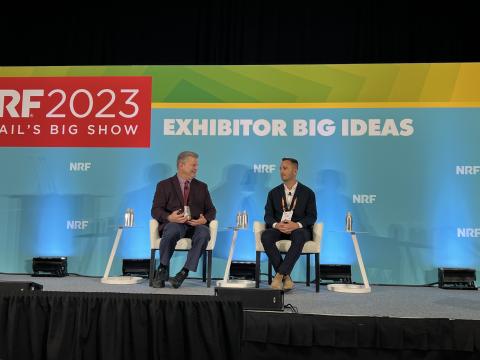
In summing up the project, Chambe praised the efficiency, accuracy, and speed that have emerged as a result.
First off, Chambe said, Anaplan’s technology has allowed Sephora’s teams to move from multiple sources into one single entry point, meaning all costs are added into the P&L. This means less work for the team and the ability to rapidly consolidate numbers in real-time. Forecasts are always updated and accurate as data points are connected, allowing for enterprise planning alignment and real-time P&L updates. Similarly, with no data reconciliation, there are fewer data discrepancies.
“You get your data right and your process right, and everything else gets better,” Chambe shared. “The job has changed for the finance team, which now spends more time talking with business partners and scenario planning and has won a lot of time. It has freed them up from data crunching and tying up numbers.”
The way consumers shop and behave has changed significantly since the pandemic — often in unexpected ways. One of the major benefits of Anaplan, according to Chambe, is the ability not only to do rolling forecasts, but to have multiple scenarios running at once without having to pause processes. The connected planning also allows for synchronization allocation models across stores, online, and through wholesale in the U.S. and Canada.
While the digital transformation has been enterprise-wide, the finance and IT teams have been particularly impacted. “Our CFO is constantly connected to the platform and can challenge the team,” Chambe said, adding that the company can now spend 60% of their time talking with business partners and preparing presentations rather than concentrating on the numbers.
When asked about creative ways to deal with excess inventory, Debicki told RIS that, "across the board, retailers leaned more heavily on data – social media trends, point-of-sale data, inflation rates, etc. – to inform their inventory decisions in this dynamic environment." In addition, retailers began to explore different pricing strategies they could leverage to boost margin dollars at different points of the year, including bundling less expensive SKUs for certain holiday promotions to try and limit carrying costs.
The Future of Drones
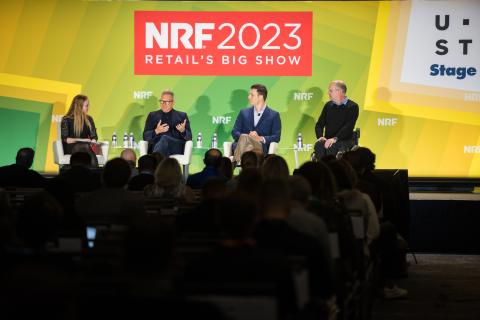
Drones are ready to lift off into a more prominent role in retail fulfillment options. Walmart, which has conducted about 6,000 drone deliveries thus far, recently announced the expansion of its drone operations to an additional 34 hubs, bringing the retailer to 37 hubs in seven states and 26 different municipalities.
During “But Will It Fy? The Lowdown on Drones,” David Guggina, executive VP, supply chain operations at Walmart pegged drone demand to follow an “S” curve as the technology ramps up in the United States and regulations enable the technology to move forward.
“You’re going to see exponential growth, and then it'll find its place as a modality within our supply chain and level off,” he said.
Beyond meeting consumers’ heightened expectations, drones can also provide a more sustainable fulfillment alternative than trucks on roads, and delivering goods to customers is just one way that Walmart expects to utilize drones in the future. The company is also exploring leveraging drones for the retrieval of goods, and, as part of this, is working with multiple partners that utilize mailboxes.
“You can imagine a world where you have a return that comes back to a Walmart Supercenter that's picked up by a drone because that drone was delivering pharmaceuticals to your home or delivering lunch for you and your family,” said Guggina.
Products that can be returned faster can then go back into the supply chain more quickly, while leveraging multiple deliveries holds the potential to “change the fabric of retail,” he noted.
“I imagine a world in the future where the vast majority of our drone hubs are off the grid completely and utilize solar power from the roofs of supercenters or carports in our parking lots,” said Guggina.
Drones also hold the potential to help Walmart support the communities it services by utilizing the drone hubs as part of emergency responses or cell tower inspection, in turn helping to mitigate operational costs. “The hubs can become tools that are used to service the community broadly,” he noted. “Delivery is obviously going to be a key piece of how the hub service our customers, but as we append alternative services, you can bring the cost of delivery down quite substantially."
4. Session Quick-Hitters: Stores
Pets in the Retail Ecosystem
Reeses the dog, available for adoption, stole the spotlight in the session “Reimagining Retail Through Consumer Insights.” Coughlin joined NRF president and CEO Matthew Shay on stage to talk about making the retail ecosystem work for the benefit of the pet. Sharing data from the vet to the groomer is good for the pet and good for Petco’s share of wallet, Coughlin explained.
He then reviewed how the pandemic shaped the pet industry. “I’m 100% convinced that pets helped us get through COVID,” he said. “No one predicted 11 million new pets in 2020,” he noted, and Petco had to retool. The retailer launched curbside in two weeks and same-day delivery in six weeks, he said, and went from having zero to over 240 vets in the last three years. Petco also did five consecutive COVID-appreciation bonuses.
Coughlin noted that so many “smart” people told him he had to get rid of his stores. But he posed the question, what is a store? If a retailer is doing BOPIS, ship-from-store out of the back, is it a store? “It’s a static asset for us.”
He also touched on how Petco is in a 10-store pilot with Lowe’s to bring Petco products to their stores, and how the retailer is getting into insurance, veterinary care, and more. “We’re increasingly thinking about ourselves as a platform.” When discussing the overall business, he commented on saving the lives of pets and keeping them healthy: “Having that mission is a much more powerful unlock than I even expected.”
The Future of the Store
The pandemic forced retailers to re-evaluate the role of the store. From design considerations, to frontline staffing, to customer journeys, brick-and-mortar has undergone many changes in just a few years. Brands today know a robust, agile store strategy depends on tech investments, including comprehensive POS cloud systems, mobile-first solutions, and easy-to-use apps.
On Monday, during “Getting Real About Cloud POS and the Future of the Store,” Aptos VP of strategy, Nikki Baird met with Calvin Anderson, VP of global digital (Dickies, Smartwool, Altra) owned by VF Corporation, and Dylan Bruntil, global director of retail technology at New Balance to discuss how their cloud POS journeys have impacted operations, and shared their perspectives on the future of the store.
“If you're looking for a different experience and coming into a store you're going to get a more personalized experience,” Bruntil shared. “You're going to get really immersed in the brand. And that's really a differentiator between stores and channels. One of the things that we've been seeing throughout 2022 is our store traffic has double-digit increases over the year. This just goes to show that the store is very much alive.”
While the store is thriving, there’s still opportunities for technology to better cater to brick-and-mortar. “I think maybe technology in the physical space is like an awkward teen stage right now,” Anderson shared.
Data — and data gathering — is a huge part of this transformation. But retailers are still grappling with getting the balance right. “Consumers are starting to understand that their data is valuable, they know when they're giving it away,” Anderson said. “And so, in a perfect world, we would make it a very even trade, which is [to say] that I am taking your data exclusively to make your experience with us significantly better.” In this sense, technology can and should “ease the labor of the store experience and exchange” and lead customers to discover products they love.
Modernizing the Store With Mobile POS and RFID
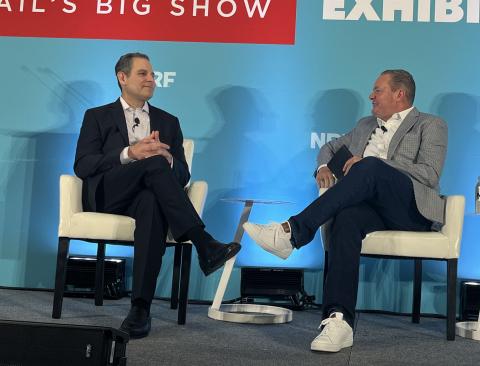
Ben Pivar, Carter’s Inc. senior VP and CIO, presented an impressive case study during “Building and Deploying Mobile POS and RFID Natively,” detailing how the children’s apparel retailer and manufacturer rolled out their own custom POS solution across its 1,000-plus store fleet. Developed and deployed in about two years, the initiative stemmed from a serious need for technology that was not only more modern to provide superior customer and employee experiences, but also more secure.
Children’s apparel is a $30 billion market, Pivar noted, with Carter’s accounting for about 11% of that. Unable to find the right vendor for their evolving needs, the multichannel retailer partnered with AWS to develop a cloud-native custom solution. As part of this, Carter’s associates began using Zebra tablets and devices, and the company reduced the footprint of their cash wrap. By leaving the ability to shrink the cash wrap down even further, the upgrades have combined for a much sleeker setup to better support Carter’s store of the future concepts, Pivar said.
Beyond making the checkout process faster, other priorities in the tech development included a more seamless tie-in with Carter’s oft-used loyalty program, more agility to enhance the solution over time through software releases, and an API-based architecture based on microservices. As a result, the company is seeing 30% faster speed of checkout, according to Pivar — “maybe even faster than that.”
5. Innovation Lab
Up on Level 4, NRF’s Innovation Lab featured over 50 innovative companies that came together to showcase the latest developments in the retail tech space. From Web3 to supply chain transparency, to robotics and digital twins, Innovation Lab was the top spot for inspiration on the cutting edge. Here are just a handful of the visionaries on hand:
LePrix: the resale market is growing 11 times faster than traditional retail — an area of opportunity that this pre-owned luxury B2B platform is seizing in style. LePrix specialists vet every order, recommend pricing, and help with specs, consolidating a largely fragmented industry.
Buywith: Video is going to be huge in 2023, and this livestream shopping platform provides a TikTok-like experience to customers, allowing them to tune into and shop their favorite influencers’ and content creators’ live shopping events.
Hivery: Co-developed with the Australian national science agency, Hivery’s AI-powered applied mathematics algorithms are reinventing the world of retail assortment strategy simulation, demand planning, and optimization solutions.
LikeAGlove: Virtual try-on technology is taken to the next level with these smart garments that measure bodies in 3D. LikeAGlove’s scanner snaps right onto your smartphone, pinpointing sizing with up to 0.12’’ accuracy by sliding over the smart squares embedded in the shorts’ fabric.
Lucky: This platform integrates with brand’s DTC websites and inventory data to connect customers with the swiftest options to purchase from the store closest to them. Lucky injects data from retailers such as Sephora and Target to streamline BOPIS and delivery services.
Eon: This product digitization platform brings together digital IDs for physical objects, linking to corresponding customer experiences by connecting to different use cases and making the whole process more traceable and interactive.
Rooom: Get ready for events in the metaverse! Rooom builds digital, 3D experiences in the same way WordPress allows for building websites, creating immersive, evergreen experiences across any platform.
FIT:MATCH: This digital twin match platform uses 3D technology to match shoppers to the right product, using computer vision to collect a full avatar in just 20 seconds. The platform can then use the avatar to make personalized recommendations to shoppers.
.arianee: Currently partnered with L’Oreal, Breitling, Moncler, YSL, and more, .arianee is a leading luxury NFT platform, enabling their portfolio of brands to tokenize digital assets, personalize experiences, build loyalty and collect data. To date, the company has minted more than 1 million digital assets.
Innovation Lab Participants

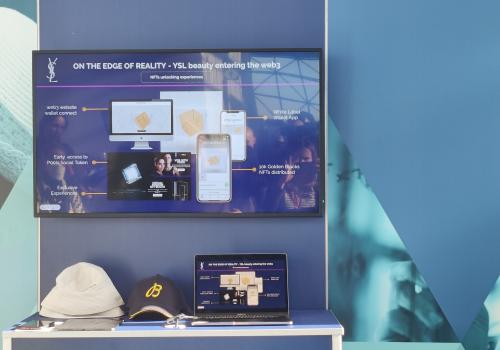
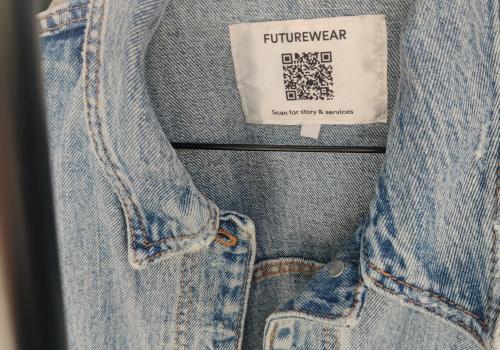
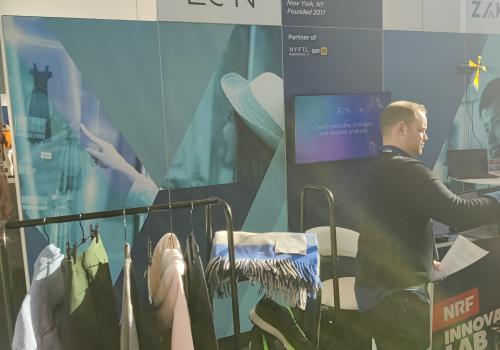
6. Consumer Product Showcase
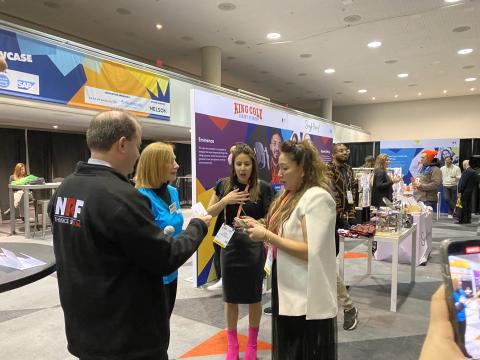
New to the show this year, NRF’s Consumer Product Showcase featured 50-plus diverse small businesses showcasing products across multiple categories. The majority (84%) of the products were from minority-owned, women-owned, veteran-owned, disability-owned or LGBTQ+-owned companies, with the aim to help retailers diversify their suppliers and connect with innovative products in categories such as food and beverage, fashion and apparel, beauty and home, and kitchen and pet.
This new exhibit also hosted a “Favorite Product” competition, offering retailers the opportunity to vote for their favorite product. RIS News witnessed the winners being announced and the excitement was infectious. Runner-up CordBrick won $10,000 for its weighted cord holder and first place went to Chica Beauty. The beauty solutions company took home a $15,000 cash prize.

7. Studies and Reports
A consumer shopping survey by Shekel Scales, advanced weighing technology, found that 90% of consumers believe technology will significantly improve the overall shopping experience, particularly tech that simplifies the self-checkout process, according to 60% of consumers. Thirty percent of consumers look for technology that helps them get in and out of the store as fast and as easily as possible.
CoreLogic recently released its Retail Challenges Boost Technology Investments study, finding that more than two-thirds of retailers (68%) plan to increase technology spending over the next three years with close to 30% planning increasing spending by 10%. Of top priority is top operational efficiency, including energy and inventory monitoring/management, according to 24% of retailers.
Treasure Data focused on customer data platforms in its recent survey —The CDP Value Chain: From Baseline Uses to Business Transformation — finding that 99% of respondents expect CDP solutions to play a larger role over the next one to two years. Additionally, of importance are data security and data privacy compliance, with 68% and 60% of survey takers, respectively, labeling them as “very important” when evaluating CDPs.
Incisiv, together with Microsoft and Blue Yonder, released their 2023 Omnichannel Experience Index, which assesses top retailers' omni-channel capabilities and experiences across four key areas: inventory visibility, frictionless fulfillment, cost and payments, and 360-degree service. The index found that shoppers are increasingly leveraging digital platforms, with 93% of all shopping journeys now starting online, up from 81% in 2020. Within inventory, results show 46% of shoppers check stock availability online before making a purchase, and 55% browse products online to see what nearby stores have available.
Ricoh USA, Inc. unveiled results for a Harris Poll that surveyed more than 2,000 Americans on their preferences for online purchases and motivating factors for using intelligent lockers to retrieve and return packages. The study found that while only 12% of Americans retrieved a package from an intelligent locker over the last year, 77% would consider using one. Additionally, Ricoh found that nearly 3 in 4 Americans (73%) say they would find special online tools or applications that help envision what a product would look like in their home or worn on their body helpful when making online purchasing decisions.
Workday recently surveyed 3,000 global workers working on the frontlines across several industries, including retail. The company found that a majority (56%) of senior executives are facing frontline employee turnover that is higher than the historical average. The need for improved retention and engagement strategies has never been clearer. Despite 20% of frontline workers planning to leave their jobs within the next three to six months, 79% of workers who feel a sense of belonging at work have no plans to leave their employer.
SOTI released a global research report titled “The Tech Effect: Strengthening the Omnichannel to Meet Consumer Demands,” showing that retailers that do not leverage tech to enhance online and in-store shopping experiences risk losing consumers, particularly amid this challenging environment. According to the report, 85% of consumers experienced availability, pricing, and shipping issues, and 51% of U.S. respondents prefer to shop with retailers who offer an experience based on their individual preferences.
Swiftly, a retail technology platform, unveiled their True Cost of a Grocery Shop survey, reporting on how consumer food shopping habits and behaviors are evolving amid rising inflation and costs. Economic conditions are significantly impacting consumers' shopping habits, with more than two-thirds indicating they are struggling to pay their grocery bills. Eighty-three percent of respondents rely on some form of coupon, rewards app, or loyalty program, and 74% have changed their grocery shopping habits in the last year as a result.
SML’s “State of Retail 2023 Part 1: Order Fulfillment and the In-Store Customer Experience” report found that out-of-stock items will be the biggest challenge for retailers in 2023. According to the report, 48% of retailers believe frequently out-of-stock items are the biggest challenge to serve customers and 48% consider improving the in-store customer experience as a top priority. Additionally, 39% of retailers say labor and staffing shortages were directly impacting operations at the in-store level.
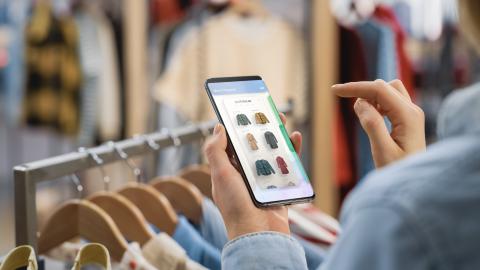
8. Retailer Deployments
Schnuck Markets, Inc. is tapping into Logile, Inc.’s Flexible Scheduling workforce management platform. The technology allows approved associates to bid on open shifts on demand without committing to a recurring schedule. This increases flexibility and associate engagement while optimizing labor resources.
Festival Foods, a family-owned grocery retailer, is simplifying its transition to the cloud by tapping into a new collaboration between SymphonyAI, an AI SaaS company, and Oracle. Festival Foods will be able to utilize Oracle’s performance monitoring and GPU-accelerated computing within Symphony AI’s platform.
Women’s swimwear and resort wear retailer Everything But Water has deployed a cloud-native unified commerce solution powered by Manhattan Associates Inc. as part of its digital transformation project. The tech was implemented across 85 retail locations in the U.S. and includes point of sale, order management, and store inventory and fulfillment capabilities.
Dirty Dough, a cookie franchise, is implementing digital menu boards, promotional screens, and employee communication screens with the help of Hughes Network Systems, LLC. The digital signage solutions will display and promote the retailer’s rotating selection of cookie flavors, guide employees, and enhance the in-store experience. The tech will also display curated customer comments from online reviews and integrate with Dirty Dough’s point-of-sale system to improve operational efficiency.
Outdoor-lifestyle retailer Roots is working with NewStore to retrofit 100 of its stores across Canada and the U.S. with order management and store fulfillment technology that will reduce shipping times, improve inventory accuracy, and maximize inventory sell-through enterprise-wide. The brand will be leveraging the solution’s proprietary routing logic to allocate order requests across its stores and distribution centers.

9. Tech Announcements
Digital services and consulting company Infosys launched Infosys Equinox Studio to help retailers shape, integrate, publish, and manage next-generation composable, computational commerce experiences from a single low- or no-code, cloud-native platform. Using the platform, retailers can manage their digital experiences across channels and integrate any cloud-based, service-oriented applications.
Zebra Technologies Corporation introduced The Modern Store by Zebra, a framework for retailers that helps retailers tackle their store operations by optimizing inventory, engaging associates, and elevating the customer experience. The solution removes friction by tapping into modern capabilities, advanced collaboration, optimized workforce management, and streamlined task management.
Hughes Network Systems, LLC, debuted its power distribution unit Hughes Active Power Edge. Designed for managed services, the PDU monitors power and connection status at each endpoint and leverages artificial intelligence to reset outlets and power cycle connected devices as needed.
Revionics, an Aptos company and retail pricing, promotion, and advanced analytics solutions provider, launched Revionics Promotions Planning and Optimization. The platform leverages data science to enable inventory-aware, personalized promotions. The AI-powered framework provides more accurate forecasts, increased personalization capabilities, and end-to-end collaborative workflows.
SAS deployed its Intelligent Planning Cloud, providing retailers and consumer goods companies with precise demand planning. The tech is available on SAS Cloud powered by Microsoft Azure and allows companies to react in near-real time to operational and market conditions and model future-state scenarios.
AI merchandising and personalization provider Coveo has released a new Merchandising Hub. The center features a dashboard for operationalizing campaigns, viewing insights on revenue opportunities, customizing product discovery, creating recommendation strategies, and more. Tapping into artificial intelligence allows the company to provide more targeted personalization.
Learn More About Coveo
Franchise pool service retailer Poolwerx is tapping Spryker to connect its digital and retail store experiences, enabling commerce across the full network. The platform includes a customer e-commerce portal, a franchise partner portal where they can manage their own products and orders, and an operator portal that provides increased visibility and operational capabilities across all channels.
Samsung unveiled a new edition of Samsung Kiosk solutions: Samsung Kiosk Windows 10 IoT Enterprise. The secure self-service tech combines a touch display with a speaker, printer, scanner, and payment solution. The technology will now also be available in Celeron i3, i5, and i7, as well as Windows Operating Systems (OS).
Computer-vision and artificial intelligence company Everseen has expanded its suite of products: Evereagle, Evershelf, Everstock, and Eversolve. The tech provides end-to-end computer vision AI for retailers from the checkout through the shop floor and the back of the store and beyond. Capabilities include increased insights for loss prevention and supported inventory management.
Cassida Pro has launched a split, open-air recycler, RevolAir SR-B1, that allows retailers to standardize and automate their cash operations at a lower cost. The patent-pending recycler enables session-based counting, packaging, and inventory recording of all on-site cash registers, tills and drawers, as well as cash storage like safes and change drawers.
Ottonomy.IO exhibited the Ottobot Yeti, an autonomous delivery robot capable of unattended deliveries. The robot can make multiple deliveries in a single trip, using four-wheel drive and four-steering wheels to enable a zero radius turn and navigate tight spaces.
Shekel Scales, a provider of weighing technology, recently launched a smart cart weighing solution that enables frictionless shopping, increased security, and legal-for-trade weighing for retailers. The solution weighs both fresh produce and packaged items.
More Tech Innovation
- Microsoft released a set of new features in Teams, Viva, and other Microsoft apps that will help support frontline workers amidst digital transformation.
- ACI Worldwide launched ACI Instant Pay, a real-time payments solution that enables merchants in the U.S. to accept online, mobile and in-store payments instantly.
- Locala announced Dynamic Commerce Areas (DCA), a geo-targeting tech that highlights areas where people are most likely to visit a store later on.
- Elastic Path launched Composable Frontend, which automates building modular, performant digital commerce front-ends customizable for brands’ specific needs.
- Epson released four new m-Series thermal receipt printers: the OmniLink® TM-m30III, TM-m30III-H, TM-50II, and TM-50II-H. They deliver enhanced connectivity in a compact enclosure.
- Veeve Inc., launched Veeve Connected Screen, an in-store personalized content delivery platform that combines aisle location in the store, promotional information, shopper identity, and loyalty with advertising, meal recipes, video, and more.
- Google Cloud launched a new shelf checking AI solution built on its Vertex AI vision platform. This gives retailers the ability to recognize billions of products to ensure in-store shelves are well-stocked.
- OnQ unveiled a new line of adjustable retail security brackets that promote sustainability in retail merchandising, enabling retailers to securely display phones or smart watches.
- Kore.ai launched RetailAssist, a conversational commerce assistant solution that enables retail and e-commerce companies to modernize, scale, and transform operations through self-service automation, personalization, and omnichannel fulfillment.
- Nexite, released its Connected Merchandise Solution, a module within the Nexite platform that delivers real-time customer journey analytics to help retailers increase in-store revenue and margins.
- Fluent Commerce announced the general availability of Fluent Big Inventory, which uses machine learning technology to intelligently process multi-source inventory data at scale to act as an inventory hub.

10. Vendor Partnerships
Microsoft has partnered with AiFi to create Smart Store Analytics which provides e-commerce level shopper analytics for physical, smart store spaces. As part of these updates to Microsoft Cloud for Retail, the company also developed Store Operations Assist, which delivers data-driven tools store associates can leverage to increase efficiency and elevate customer experiences.
Microsoft is also working with BigCommerce, an open SaaS e-commerce platform, to release Microsoft Ads and Listings in the BigCommerce Marketplace. BigCommerce merchants of all sizes in the U.S., UK and ANZ can now directly integrate their stores to reach Microsoft Advertising’s audience and engage more with ads.
Google Cloud is expanding its relationship with Lucidworks, combining Fusion technology with Google’s Retail Search functionality to elevate product discovery. The deep learning tech increases relevancy across the shopper journey, tapping into shopper intelligence. Google Cloud is also working with AI company Brain Corp to launch BrainOS Inventory Insights, an in-store inventory analytics platform for retailers.
Supply chain visibility platform project44 is working with SAS, on a new retail ecosystem partner collaboration which will focus on harnessing supply chain data analytics to minimize disruptions impacting the customer experience.
Unified supply chain tech company RELEX Solutions is working with workforce management company Legion Technologies to provide retailers with increased efficiencies across supply chains and store operations through automation and advanced data. Their combined tech shares critical, real-time data so retailers can improve demand forecasting and replenishment processes, transforming their in-store labor operations and the hourly employee experience.
Online merchandising platform Advanced Commerce is collaborating with real-time personalization tech company Dressipi to bring hyper-personalization and outfit recommendations to apparel retailers. The companies tap into NLP search to reduce bounce rates, boost conversation rates, and give retailers more control over their virtual merchandising.
SeeChange Technologies, a retail-focused computer vision AI tech company, is partnering with Diebold Nixdorf, a designer of retail consumer and staff journeys. Together the companies launched the first in a series of AI-powered self-checkout solutions. The company’s platforms, Vynamic Smart Vision and Seeware, leverage machine learning to recognize fruits, vegetables, baked goods, and other products without a barcode.
VMware, Inc., in collaboration with Stratodesk, introduced a new solution to modernize retailers’ point of sale (POS). VMware Retail POS extends the lifecycle of current POS systems to deliver ROI, reduce security risks, maximize store uptime, and improve the customer experience. The technology utilizes virtualization software to improve life spans beyond the typical three to five years.
Unified commerce SaaS company OneView Commerce is working with Anker Kassensysteme GmbH to launch a self-checkout technology. Self-checkout combined with point of sale software allows retailers to lower costs, elevate consumer experiences, and increase return on investment. The tech includes integration into in-store and backend systems, an analytics dashboard to manage interventions, and expedited convertibility from self-service to full-service cashier mode.

